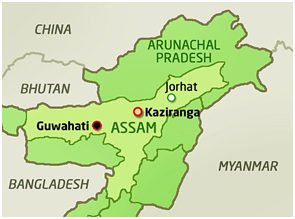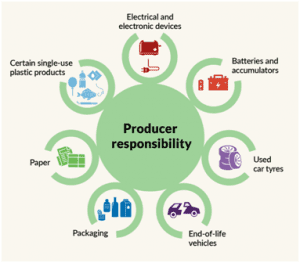ENVIRONMENT AND ECOLOGY
1. KAZIRANGA NATIONAL PARK
TAGS: PRELIMS- GS-III- ENVIRONMENT
THE CONTEXT: The Union Ministry of Environment, Forest and Climate Change recently sought a “factual report” on the rhino population enumeration conducted in the Kaziranga National Park and Tiger Reserve in March 2022.
THE EXPLANATION:
About Kaziranga National Park:
- Location: It is located in the Golaghat and Nagaon districts of Assam.
- It was declared a national park in 1974.
- It is also a UNESCO World Heritage Site and houses two-thirds of the total world population of greater one-horned rhinoceros.
- It is the largest undisturbed area in the Brahmaputra Valley floodplains.
- Vegetation: It is a mix of eastern wet alluvial grasslands, semi evergreen forests and tropical moist deciduous forests.
Flora:
- It is primarily famous for its dense and tall elephant grasses intermixed with small swamplands.
- It also includes an abundant cover of water lilies, water hyacinths and lotus.
- Rattan Cane, a type of climbing palm, is also found here.
Fauna:
- Important wildlife found are One-horned rhinoceros, Leopard, Fishing Cat, other Lesser cats, royal Bengal tiger, Large Indian Civet, Small Indian Civet, Sambar, Barking deer, Hog deer, Gaur, Hog Badger, Capped Langur, etc.
- It is also one of the last remaining homes of the endangered and endemic western hoolock gibbon, the only species of apes found in India.
- It is home to approximately 478 species of both resident and migratory birds.
- It is one of the last homes of the critically endangered Bengal florican.
2. EXTENDED PRODUCER RESPONSIBILITY
TAGS: PRELIMS- GS-III- ENVIRONMENT
THE CONTEXT: India’s Extended Producer Responsibility (EPR) framework for used tyres, batteries, and revised rules for e-waste and plastics kindled interest among the G20 countries.
THE EXPLANATION:
- Extended producers’ Responsibilities is a globally recognized policy used as an effective tool to put the onus on the producers for efficient end of life waste management of the plastic, electronic and electrical equipment.
- The concept of EPR responsibility is based on three foundation principles:
o Pollution prevention approach
o Life cycle thinking,
o Polluter pay principle
o EPR responsibility makes it the responsibility of the producers not only to take back products for recycling but also to design better and longer life products to minimize the amount of waste generated.

EPR in India:
EPR responsibility Certificate:
- EPR responsibility Certificate is authorized by Central Pollution Control Board which is mandatory for Producers/Importers of the Electronic products.
- Under these rules, the producers have a responsibility to delegate this responsibility to the third party or specialized organizations which manufacturers can financially aid for proper waste management.
EPR Responsibility Policies under E-Waste Management Rules:
- E-Waste (management and handling) Rules, 2016 adopted Extended Producers Responsibility for the first time in India.
- EPR responsibility under E-Waste (management) Rules, 2016 stipulates collection targets of E–Waste for producers.
- The producers are responsible for setting up collection centres for e-waste and financing and organizing a system for environmentally sound management of e-waste.
- The producers are required to have an arrangement with dismantlers and recyclers through either the Producers responsibility organization or the E-Waste exchange system.
- Marketing or selling any electronic equipment without EPR responsibility Authorization is considered a violation of the rules.
EPR responsibility Policy under Plastic Waste Management Rules:
- The Plastic Waste Management (Amendment) Rules, 2022 provide guidelines for strengthening the circular economy of plastic packaging waste as well as promoting alternatives to plastic.
- Producers of waste are mandated to ensure that generation of plastic waste is minimized, and plastic waste is not littered and stored at the source, which is then handed over to local bodies or authorized agencies.
SCIENCE AND TECHNOLOGY
3. WHAT IS MESSIER 92?
TAGS: PRELIMS- GS-III-SCIENCE AND TECHNOLOGY
THE CONTEXT: Astronomers have recently released an image of the globular cluster Messier 92 (M92) captured by the James Webb Space Telescope.
THE EXPLANATION:
About Messier 92:
- It is a bright and large globular cluster in the constellation of Hercules.
- It is located at a distance of 26,700 light-years from Earth.
- It was first discovered by the German astronomer Johann Elert Bode in 1777.
- The predominant elements within Messier 92 are hydrogen and helium.
- Messier 92 has an estimated mass of up to 330,000 solar masses.
- The cluster is approaching the Milky Way galaxy at a speed of about 112 km/s (403,200 km/h; 250,500 mph).
What is a Globular Cluster?
- Globular clusters are spherical aggregates of several thousand to millions of stars bound by gravity.
- They orbit mostly in the extended stellar halos surrounding most spiral galaxies.
- They contain some of the oldest stars in a galaxy.
- These systems are thought to have formed early on in the Universe and can serve as perfect astrophysical laboratories for astronomers to understand how stars evolve through various phases.
What is Solar Mass?
- It is the mass of the sun, which is 1.989 x 10^30 kilograms — about 333,000 Earths.
4. K- 9 VAJRA- T HOWITZERS
TAGS: PRELIMS- GS-III-DEFENCE AND TECHNOLOGY
THE CONTEXT: The Indian Army recently ordered 100 additional K9 Vajra self-propelled howitzers.
THE EXPLANATION:
About K- 9 Vajra- T howitzers :
- It is a 155 mm, 52-caliber tracked self-propelled artillery system.
- It is built by Larsen & Toubro with technology transferred from South Korean defence major Hanwha Defense based on its K9 Thunder.
- Features:
- It has all-welded steel armour up to 19mm thick.
- The main weapon is the 155mm / 52 calibre gun.
- It has a burst rate of fire of three rounds per 15 seconds and a maximum rate of fire of six to eight rounds a minute for three minutes.
- Range: 40 km
- The K9 uses a digital fire control system, by which it can fire multiple rounds that can impact a given area at the same time.
PRELIMS PERSPECTIVE
5. TEJA CHILLI
TAGS: PRELIMS PERSPECTIVE
THE CONTEXT: Recently export demand for Teja variety of red chilli has gone up due to its culinary, medicinal and other wide-ranging uses.
THE EXPLANATION:
- Chilli was originally cultivated in North Mexico but is believed to be brought to India by the Portuguese.
- It is a fine variety of Guntur chilli.
- It is a fruit that belongs to genus Capsicum.
Health benefits of Teja Chilli:
- Rich in Vitamins and Minerals like Copper, Potassium, Vitamin C, Vitamin B, Vitamin A.
- It is a powerful anti-oxidant.
- Studies suggest that it aids in weight loss.
- Clears congestion.
- Boosts mood and reduces pain.
- It has antibacterial properties that helps in curing skin infection.
- Decreases the risk of osteoporosis.
- Protects the body against prostate problems.

